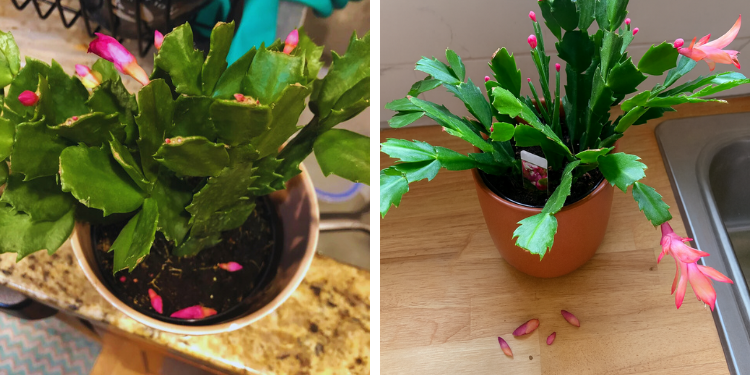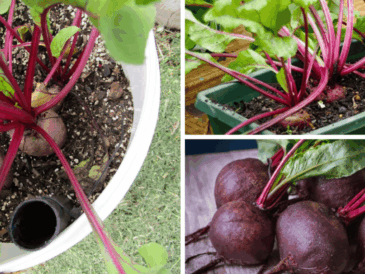Few indoor plants bring holiday cheer quite like a Christmas cactus (Schlumbergera spp.). With its cascading stems and brilliant blooms that light up homes in late fall and winter, this beloved plant is a seasonal favorite around the world.
But if you’ve ever eagerly awaited a burst of flowers only to watch your plant’s buds shrivel up and fall before they open, you’re not alone.
Bud drop is one of the most frustrating problems Christmas cactus owners face – and it can happen even when the plant looks perfectly healthy otherwise.
The good news? It’s almost always a sign that something in its environment or care routine is off, and once you identify and correct the cause, your plant can recover and bloom beautifully.
Understanding the Christmas Cactus Bloom Cycle
Before we dive into the causes of bud drop, it’s important to understand how and when this plant blooms – because timing plays a huge role in its success.
Unlike desert cacti, Christmas cacti are tropical epiphytes native to the rainforests of Brazil. They grow on trees and rocks under the forest canopy, where light is bright but filtered, temperatures are mild, and humidity is high.
They’re also short-day plants, meaning they bloom when days become shorter and nights longer – typically in late fall through winter.
The Three Phases of the Bloom Cycle
- Pre-bloom (Late Summer – Early Fall): The plant begins storing energy and forming buds. Stable conditions during this phase are crucial.
- Bud Formation (Mid-Fall): Tiny buds appear at the tips of segments. At this stage, the plant is extremely sensitive to changes in environment.
- Flowering (Late Fall – Winter): Blooms open and last for several weeks. Proper care extends the flowering period and prevents bud drop mid-bloom.
If buds form but fall before opening, it means stress occurred during the second phase – usually from changes in light, temperature, watering, or handling.
8 Common Reasons Your Christmas Cactus Is Dropping Buds – and How to Fix It
Let’s break down the most frequent culprits behind bud drop and exactly what you can do to solve each one.
1. Sudden Changes in Light Exposure
Why It Causes Bud Drop: Christmas cacti are highly sensitive to light fluctuations during the bud-forming stage.
A sudden change in light exposure – such as moving the plant to a different room, turning on bright artificial lights at night, or shifting it from shade to direct sun – can disrupt its internal clock and stress the plant.
Because it’s a short-day plant, it needs about 12–14 hours of uninterrupted darkness every night for 6–8 weeks to trigger and maintain blooming.
Even a brief period of nighttime light can interrupt this cycle and cause buds to abort.
What to Do:
- Keep the plant in one consistent location during the pre-bloom and bud stages.
- Avoid turning on lights near the plant at night. If it’s near a window with streetlights, cover it with a light cloth in the evening.
- Once buds form, maintain bright, indirect light but do not expose it to harsh direct sun, which can scorch tissues and lead to stress.
Pro tip: East-facing windows are ideal for stable, gentle light levels.
2. Temperature Fluctuations or Drafts
Why It Causes Bud Drop: In their native rainforest environment, Christmas cacti experience consistent, moderate temperatures.
Sudden cold drafts, hot air from heaters, or rapid day-night temperature swings can shock the plant and cause buds to drop.
The most common scenarios include:
- Placing the plant near drafty windows or doors.
- Positioning it near radiators, heating vents, or fireplaces.
- Moving it outdoors or into a different room with a temperature difference of more than 10°C (18°F).
Optimal Temperature Range:
- Pre-bloom and bud set: 60–65°F (15–18°C) at night and 65–75°F (18–24°C) during the day.
- Blooming: Slightly cooler temperatures (around 60–70°F) help flowers last longer.
What to Do:
- Keep your plant away from heating vents, exterior doors, and drafty windows.
- Avoid placing it on cold windowsills in winter.
- If moving it outdoors in fall to trigger bud formation, bring it back indoors before nighttime temps drop below 50°F (10°C).
3. Overwatering or Underwatering
Why It Causes Bud Drop: Christmas cacti like consistent moisture – not too wet and not too dry. When watering fluctuates dramatically, the roots can become stressed, leading to bud drop.
- Overwatering suffocates roots and causes rot, depriving buds of nutrients and water.
- Underwatering leads to dehydration, causing buds to shrivel and fall before blooming.
What to Do:
- Water when the top 1–2 inches of soil feel dry to the touch.
- Use a well-draining cactus or succulent mix, and make sure the pot has drainage holes.
- Reduce watering slightly in early fall during the bud initiation phase, then resume regular watering once buds appear.
Pro tip: During blooming, keep soil evenly moist but never soggy – a stable water supply helps buds develop fully.
4. Low Humidity Levels
Why It Causes Bud Drop: Christmas cacti originate from humid rainforests. Indoor air, especially in winter when heating systems run, is often too dry – and low humidity can cause buds to dry out and fall.
Signs your plant needs more humidity:
- Buds shrivel and drop prematurely.
- Stem segments look slightly wrinkled.
- Flowers are smaller or fail to open fully.
What to Do:
- Aim for 50–60% humidity around the plant.
- Use a humidifier, or place a shallow tray of water and pebbles beneath the pot (without letting roots sit in water).
- Group plants together to create a microclimate of higher humidity.
Pro tip: Misting can provide a short-term boost, but maintaining consistent humidity is more effective long-term.
5. Stress From Moving or Repotting
Why It Causes Bud Drop: Christmas cacti dislike being moved once buds have formed.
Relocating the plant, rotating it, or repotting too close to blooming season can shock the plant, triggering it to drop buds as a survival mechanism.
Even slight changes – like moving it from one windowsill to another – can disrupt its environmental balance of light, humidity, and temperature.
What to Do:
- Avoid moving or rotating the plant from the time buds appear until flowering is complete.
- If you must repot, do it in late winter or early spring, after blooming has finished.
- Handle the plant gently and avoid disturbing its roots during the blooming phase.
Pro tip: If you move your cactus outdoors for summer, bring it inside before buds form in fall to avoid triggering stress.
6. Nutrient Imbalance
Why It Causes Bud Drop: While Christmas cacti aren’t heavy feeders, nutrient imbalances – especially too much nitrogen – can encourage leafy growth at the expense of blooms.
Conversely, nutrient deficiencies (particularly phosphorus and potassium) can weaken bud development and cause them to fall prematurely.
What to Do:
- Feed your plant with a balanced, water-soluble fertilizer (like 10-10-10) monthly from spring to late summer.
- In late summer and early fall, switch to a low-nitrogen, high-phosphorus fertilizer (like 5-10-10) to promote bud formation.
- Stop fertilizing once buds begin to form to avoid overstimulation.
Pro tip: If you haven’t fed your plant in months, a weak dose of fertilizer may help boost blooming – but never overfeed during the bud stage.
7. Pest or Disease Issues
Why It Causes Bud Drop: Although Christmas cacti are generally resistant to pests and diseases, infestations or infections can stress the plant and cause it to drop buds as it tries to conserve energy.
Common culprits include:
- Mealybugs – Look for white cottony clusters in leaf joints.
- Spider mites – Fine webbing and speckled leaf surfaces.
- Root rot – Caused by overwatering, leading to yellowing segments and bud drop.
- Fungal diseases – Blackened stem bases or mushy roots.
What to Do:
- Inspect your plant weekly, especially the undersides of segments and near the soil line.
- Wipe away pests with a cotton swab dipped in rubbing alcohol.
- Use insecticidal soap or neem oil for persistent infestations.
- If root rot is suspected, remove the plant from its pot, trim away rotted roots, and repot in fresh, well-draining soil.
Pro tip: Healthy plants resist pests better – avoid overwatering and keep air circulating around your cactus.
8. Natural Aging or Overcrowding
Why It Causes Bud Drop: If your Christmas cactus is several years old and has never been divided or repotted, it may be rootbound or suffering from nutrient depletion.
Overcrowded roots struggle to absorb water and nutrients efficiently, leading to bud loss.
What to Do:
- Repot mature plants every 3–4 years in a slightly larger container with fresh soil.
- Consider dividing an overgrown cactus into smaller plants in early spring.
- After repotting, give the plant time to re-establish before expecting heavy blooming.
Pro tip: Regular pruning of older segments after flowering encourages new growth and future bud production.
Bonus Tips: How to Encourage Maximum Blooms
Once you’ve addressed the causes of bud drop, a few proactive care strategies can help ensure your Christmas cactus blooms to its fullest potential every year.
1. Trigger Blooming With Darkness
To initiate blooming, provide 12–14 hours of complete darkness per night for 6–8 weeks in early fall. A closet or unused room works well if your home stays too bright.
2. Keep Conditions Stable
Consistency is key – avoid sudden changes in temperature, humidity, watering, or light once buds appear.
3. Support the Blooming Phase
During flowering, keep the plant slightly cooler (around 60°F) and ensure soil stays evenly moist. Avoid fertilizing until flowering is complete.
4. Deadhead Spent Blooms
Removing faded flowers encourages the plant to redirect energy into new buds and future growth.

A Christmas cactus dropping its buds can be frustrating, but it’s rarely a sign of anything serious.




